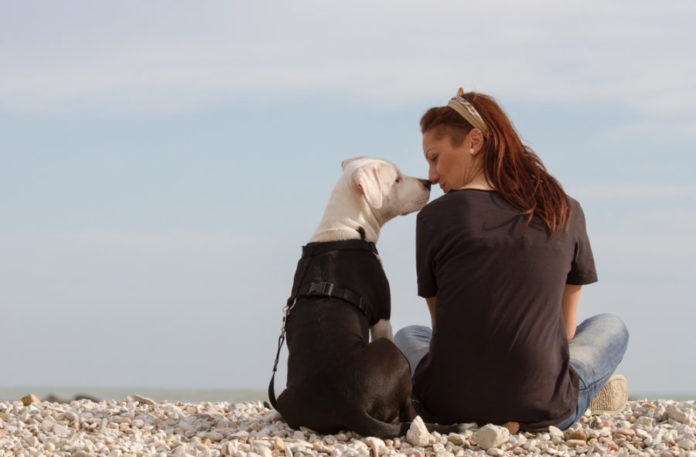Understanding your dog’s mind and emotions

How smart is your dog? How many emotions does he have access to? Recent research into canine behavior and cognition is yielding some surprising results.
If you think our dogs know and feel more than we think they do, you’re correct. We live in an age of discovery when it comes to canine behavior, and a multitude of recent studies offer intriguing insights into the cognitive and emotional lives of dogs. We are learning that dogs have a unique bond with us and are more mentally capable than previously believed. Although the jury is still out on their ability to experience complex human emotions such as guilt, shame and jealousy, we do know dogs can read our body language and respond extremely well to it. They can also recognize our faces and decipher our emotions. They look to us for information, and use it to build a relationship with us and maintain their safety. Let’s delve deeper into the canine mind and what we’ve discovered about it in recent years.
Our relationship with dogs
Dogs have evolved to have a close relationship with us; in fact, studies show that humans are important to dogs. Researchers have found that when dogs interact with their owners, they display responsive behaviors similar to those seen in human infants. Dogs will approach their owners when stressed, use them as a safe base for exploration, and exuberantly reunite with them after separation. These results support the idea that dogs form real bonds to their people. This is rather unique considering that canines and humans are two different species. By exploring this relationship, we can determine what dogs have learned from living with humans and what capacities they have for complex communication, cognition and emotion.
Canines have exceptional social competence
Dogs live and work in close association with humans and have therefore developed exceptional social communication skills. This is a form of social competence — the ability to get along with people; knowing what is expected for social interactions; “reading” people’s facial expressions and gestures; recognizing emotions; and communicating effectively. Researchers from dog cognition labs, including the Max Planck Institute and the Duke Canine Cognition Center, have found that dogs routinely outperform chimpanzees in tests of social cognitive ability.
What do dogs know about human emotions?
Studies show that dogs can recognize our faces. Ludwig Huber and colleagues at the Clever Dog Lab found that dogs discriminate between images of their owners and unfamiliar people. Research by Laura Cuaya and others, using functional magnetic resonance imaging (fMRI), demonstrate that dogs use areas of their brains similar to the ones we use for processing human faces and voices. Dogs determine the meaning of our facial expressions using information from multiple facial features (not just the eyes). Researchers Sanni Somppi and colleagues at the University of Helsinki further found that dogs respond rapidly and with avoidance behavior to threatening facial expressions in people.
Dogs also can decode the emotion in our voices. In fMRI studies, Atilla Andics with the Comparative Ethology Research Group found that the brain regions dogs use for processing human voices respond more strongly to positive vocalizations. To further understand what dogs know about our emotional states, Natalia Albuquerque and colleagues presented dogs with human faces that were either happy or angry and paired the presentations with a vocalization that was either positive or negative. Dogs looked longer when the emotion on the face matched the emotion of the vocalization. These findings show that dogs can understand the validity of emotional information, and can process these cues in a similar way we do.
How many emotions are dogs capable of?
We know dogs are fully able to experience simple emotions such as happiness and fear, but what about more complex feelings?
Guilt and shame
Dogs are exceptionally good at reading and responding to us, but that muddies the waters when we try to determine if they are actually experiencing the emotions we attribute to them, or are simply reacting to us. In studies of “the guilty look”, Alexandra Horowitz at Horowitz Dog Cognition Lab found that the canine “guilty look” was an appeasement gesture given in response to a person’s behavior or body language, rather than a display of actual guilt. The “guilty look” depends primarily on the person’s behavior (such as scolding) rather than on whether or not the dog is actually feeling guilty.
The same concept applies to shame. There are many “dog shame” memes floating around the internet, but are these dogs really showing “shame” or are they simply trying to dispel the ire of an unhappy person?
The next time you think your dog is manipulating you, think again; there is likely a simpler explanation for his behavior. This is not to say dogs are incapable of emotions such as guilt or shame; they do have neural structures that correspond to similar structures in the human brain associated with these emotions. But we just don’t know yet.
Jealousy
Jealousy is another complex human emotion often attributed to dogs. The Horowitz Dog Cognition lab looked into canine jealousy with a study in which pairs of dogs were asked to “sit”. One dog received a consistent reward each time, while the other received either too little or too much reward. The dogs were then allowed to choose which trainer to approach on their own: the fair or “unfair” one. When dogs were under-rewarded, they chose both trainers equally. In the over-rewarding trial, however, the dogs chose the “unfair” trainer. This result suggests the dogs were less concerned with fairness or jealousy, and more driven by which trainer was providing more food.
However, dogs may possess a more primordial form of jealousy-like behavior similar to what has been noted in human infants — competition for parental attention. Christine Harris and Caroline Prouvost tested dogs using a model designed to test for jealousy in human infants. They found the dogs exhibited behaviors consistent with jealousy, such as snapping at the object of their jealousy, getting closer to the owner, pushing the object of jealousy away, or touching the owner when they paid attention to the object.
These studies indicate that dogs may not be capable of the complex form of jealousy human adults experience, but they may possess this emotion in a simpler form.
Dogs know when we pay attention to them
Studies show that dogs know when we are paying attention to them, and can capitalize on that information. In a study by Brian Call from the Duke Canine Cognition Center, dogs were forbidden to take a piece of food, after which the experimenters either kept their eyes open and on the food, closed their eyes, feigned distraction with a computer game, or turned their backs. The dogs took less food when the people were paying attention to them, but took more during the other three scenarios when the experimenters appeared not to be taking notice of them.
Similarly, Marta Gácsi and colleagues at The Clever Dog Lab found that dogs will obey commands faster when the person giving the command is facing them and in sight. They also learned that dogs can tell the difference between intentional communications, such as pointing to food, versus accidental pointing, such as when checking a wristwatch.
In another study, Juliane Bräuer at the Max Planck Institute found that dogs know what people can see, and use that information to make choices. In tests during which dogs were challenged with forbidden food, but where a large barrier obstructed the human’s view of the food, the dogs took the food more often than when the person could clearly see it. These findings indicate that dogs know when we are paying attention to them, and use this information to guide their behavior.
Dogs look to us for emotional information
Dogs also use information on how a person feels about a situation to determine how they will react, a phenomenon called social referencing. Isabella Merola and others found that when dogs received positive messages from a person approaching an unfamiliar object, they were more likely to also approach the object than dogs who observed a negative message from the person. Dogs responded even more strongly when their owners were the ones giving the messages. This shows that dogs take in emotional information from us and use it to determine how they will respond to a situation.
Future studies
We aren’t finished learning about the minds and emotions of our canine companions. Future studies may further evolve our perceptions of what our dogs are capable of doing and feeling. For now, know that your dog is bonded to you and looks to you for information on how to navigate his world. Be careful not to betray this relationship by attributing negative motivations to him when you feel he misbehaves. There is often a much simpler, more innocent — and more inherently canine — motivation underlying his behavior!




